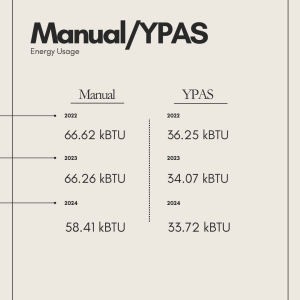On April 10, 2024 JCPS voted to end busing for most of the magnet and traditional schools due to inequity and ineffectiveness in prior busing plans. Starting this school year, Manual families and students are now responsible for their commute to school. Consequently, the number of cars commuting to and from Manual has increased, exacerbating air pollution.
Energy, despite the advantages that it provides, contributes to the environmental deterioration that the world presently suffers from. While energy production is often associated solely with power plants, it is also present in the simple powering of a vehicle. This powering occurs through fossil fuel combustion that converts chemical energy to mechanical energy to turn the wheels.
“[W]e document the considerable evidence showing that people living, working, and learning within 300 meters of arterials and interstates are exposed to greater levels of hazardous air and noise pollution than the population overall,” an Urban Institute report said. Arterial refers to a high urban capacity road connecting various city parts.
Manual, one of the 167 schools in JCPS, is located in Old Louisville and within 300 meters of various roadways. This neighborhood is surrounded by Kentucky Route 1020 and Interstate 65, exposing nearby communities to an onslaught of air pollution.
Additionally, the report demonstrates that the individuals disproportionately affected by this phenomenon are considered to be living in poverty, and often suffer from a restricted number of housing options.
Aside from the increased number of vehicles in the community, Manual experiences another contributor to air pollution: energy usage. In a chart showing the energy usage of all JCPS buildings from low to high, Manual (not including YPAS buildings) used 58.41 kBTUs (a kilo British thermal unit) per square foot in 2023. The kBTU is the standard method for measuring various energy units.

This method of measuring energy is used so that JCPS can price the amount of energy each facility uses. While Manual’s energy usage has decreased since 2022, it is still one of the largest energy users among all JCPS schools. As of 2023, including both YPAS buildings, Manual uses more energy than any other school per year.
In the past, energy usage throughout the United States was unregulated with cheaper energy prices. Schools also focused on creating the spaces necessary for education, rather than optimizing them for the future. In the 1970s, Manual’s use of temporary structures for classrooms and office space due to high enrollment rates was an example of this.
Manual, along with other JCPS schools, has adopted ways to reduce energy usage throughout the building. For instance, the air conditioning in all JCPS schools shuts off after a specified time to save energy. Schools can request more time to accommodate sports practices, club meetings, tournaments, and other activities.
Manual students have fostered and led their own group, the Environmental Club, to tackle the school’s environmental challenges and bring awareness to the student body. In response to growing concerns regarding the school’s environmental impact, the group is focused on local action to raise awareness and drive change, particularly in reducing energy consumption within the building.
The club has taken several steps to improve sustainability on campus, including clearing a portion of vegetation to create a native flower garden in the courtyard that attracts pollinators and enhances biodiversity. Pollinators, such as bees, butterflies and birds, are essential for maintaining healthy ecosystems, as they facilitate plant reproduction. The pollination process contributes to clean air and water to maintain food supplies.
In addition to their landscaping efforts, the club oversees building-wide recycling every Thursday and is now looking to expand this program by including the recycling of cardboard lunch trays, further reducing waste and promoting eco-friendly practices within the school. The club also takes action to educate the Manual community by placing stickers on dispensers to encourage students to limit the number of paper towels used, helping to reduce unnecessary waste and promote mindful consumption.
“We actually talked with the custodial staff and they don’t have to order as many paper towels when those stickers are on there,” Ms. Angela Page (Science) said, highlighting the effectiveness of this initiative in reducing unnecessary waste.
While the club has many ambitions, it can be difficult to find funding. One of their goals is to rely more on clean energy, or solar power.
In 2023, the Environmental Club partnered with OurEarthNow to install solar panels at Manual. OurEarthNow is a Kentucky group of youth environmental activists. One of OurEarthNow’s goals is to place solar panels on the roofs of schools that their members attend, facilitating communication between faculty and the youth organization. Environmental Club and OurEarthNow fundraised $5,000 to install 5 solar panels and they are expected to last up to thirty years.
Environmental Club continues to explore opportunities to expand its clean energy efforts, such as seeking additional funding or partnerships. By doing so, they hope to continue supporting Manual in reaching its sustainable energy usage goals and ensure the school’s long-term solar power functionality.
Despite Manual’s shortcomings in the upkeep of green energy projects, JCPS has made significant strides toward sustainability through its long-standing partnership with Louisville Gas & Electric Company (LG&E). This year, the district completed major energy-efficient upgrades in eight schools, improving lighting, reducing operating costs and lowering overall energy consumption while creating a more comfortable learning environment for students.
Since 2011, JCPS has undertaken over 500 energy-saving projects across 50 buildings, leveraging LG&E’s Business Rebates program to offset costs and maximize efficiency. These initiatives reflect JCPS’s commitment to sustainability, reducing its environmental footprint while ensuring modern, energy-efficient facilities for students and staff.
Despite past initiatives, the issue of increased air pollution due to major roadways and increased car traffic surrounding the community still poses a serious threat to student well-being and possibly even academic achievement.
“Ambient air pollution has been associated with various adverse health effects, including impaired cognitive function. Studies have associated air pollution exposure with neuroinflammation and neurodegeneration, leading to increased risk of neurological disorders, and accelerated cognitive decline,” Wenxin Lu, PhD in Environmental Health Sciences at UC Berkeley, said.
JCPS has made significant progress in enhancing energy efficiency and sustainability. If Manual and JCPS continue to work with local partners, the surrounding community could benefit from green initiatives. Ensuring clean air and energy-efficient facilities is a necessary responsibility that public institutions such as schools must prioritize.
















